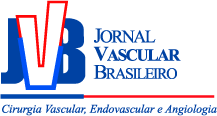Mapeamento ecográfico da bifurcação das artérias carótidas extracranianas para planejamento cirúrgico: diferenças baseadas no gênero do paciente
Ultrasonographic mapping of the extracranial carotid artery bifurcation for surgical planning: gender differences
Sandra Maria Pontes; Fanilda Souto Barros; Leonard Hermann Roelke; Maria Alice Taylor Almeida; João Luiz Sandri; Cláudio de Melo Jacques; Daniela Pontes Nofal; Sérgio X. Salles Cunha
Resumo
Palavras-chave
Abstract
Keywords
References
Sandri JL. Endarterectomia carotídea somente com duplex. Ultra-sonografia vascular. 2000:71-5.
Ascher E, Markevich N, Kallakuri S. Intraoperative carotid artery duplex scanning in a modern series of 650 consecutive primary endarterectomy procedures. J Vasc Surg. 2004;39(2):416-20.
Salles-Cunha SX, Ascher E, Hingorani AP. Effect of ultrasonography in the assessment of carotid artery stenosis. Vascular. 2005;13(1):28-33.
Ascher E, Marks NA, Schutzer RW. Duplex-assisted internal carotid artery balloon angioplasty and stent placement: a novel approach to minimize or eliminate the use of contrast material. J Vasc Surg. 2005;41(3):409-15.
Ascher E, Hingorani A, Marks N. Mini skin incision for carotid endarterectomy (CEA): a new and safe alternative to the standard approach. J Vasc Surg. 2005;42(6):1089-93.
Menezes FH, Luccas GC, Matsui IA. Avaliação através da ultra-sonografia duplex da medida de reestenose da carótida interna dos pacientes submetidos à endarterectomia aberta da bifurcação carotídea, com eversão parcial da carótida interna. J Vasc Bras. 2005;4(1):47-54.
Ascher E, Hingorani AP, Marks N. Duplex-assisted internal carotid artery balloon angioplasty and stent placement. Perspect Vasc Surg Endovasc Ther. 2007;19(1):41-7.
Freitas P, Piccinato CE, Martins WP. Aterosclerose carotídea avaliada pelo eco-dopppler: associação com fatores de risco e doenças arteriais sistêmicas. J Vasc Bras. 2008;7(4):298-307.
Blackshear Junior WM, Connar RG. Carotid endarterectomy without angiography. J Cardiovasc Surg. 1982;23(6):477-82.
Chiesa R, Melissano G, Castellano R. Carotid endarterectomy: experience in 5425 cases. Ann Vasc Surg. 2004;18(5):527-34.
Pan XM, Saloner D, Reilly IM. Assessment of carotid artery stenosis by ultrasonography, conventional angiography, and magnetic resonance angiography: correlation with ex vivo measurement of plaque stenosis. J Vasc Surg. 1995;21(1):82-9.
Hernandez N, Salles-Cunha SX, Daoud YA. Factors related to short length of stay after carotid endarterectomy. Vasc Endovascular Surg. 2002;36(6):425-37.
Comerota AJ, Salles-Cunha SX, Daoud Y. Gender differences in blood velocities across carotid stenoses. J Vasc Surg. 2004;40(5):939-44.
Ascher E, Markevich N, Hingorani A. Pseudo-occlusions of the internal carotid artery: a rationale for treatment on the basis of a modified carotid duplex scan protocol. J Vasc Surg. 2002;35(2):340-5.
Beebe HG, Salles-Cunha SX, Scissons RP. Carotid arterial ultrasound scan imaging: A direct approach to stenosis measurement. J Vasc Surg. 1999;29(5):838-44.
Endarterectomy for asymptomatic carotid artery stenosis. JAMA. 1995;273(18):1421-8.
Hobson RW 2nd, Weiss DG, Fields WS. Efficacy of carotid endarterectomy for asymptomatic carotid stenosis: The Veterans Affairs Cooperative Study Group. N Engl J Med. 1993;328:221-7.
Wardlaw JM, Stevenson MD, Chappell F. Carotid artery imaging for secondary stroke prevention: both imaging modality and rapid access to imaging are important. Stroke. 2009;40(11):3511-7.
Hashimoto H, Tagaya M, Niki H. Computer-assisted analysis of heterogeneity on B-mode imaging predicts instability of asymptomatic carotid plaque. Cerebrovasc Dis. 2009;28(4):357-64.
Biasi G, Froio A, Dietrich EB. Carotid plaque echolucency increases the risk of stroke in carotid stenting: the Imaging in Carotid Angioplasty and Risk of Stroke (ICAROS) study. Circulation. 2004;110(6):756-62.
Roffi M, Lüshcer TF. Management of patients with carotid artery stenosis. Herz. 2008;33(7):490-7.
Lanzino G, Tallarita T, Rabinstein AA. Internal carotid artery stenosis: natural history and management. Semin Neurol. 2010;30(5):518-27.
Kreiza J, Arkuszewski M, Kasner SE. Carotid artery diameter in men and women and the relation to body and neck size. Stroke. 2006;37(4):1103-5.
den Hartog AG, Algra A, Moll Fl. Mechanisms of gender-related outcome differences after carotid endarterectomy. J Vasc Surg. 2010;52(4):1062-71.



